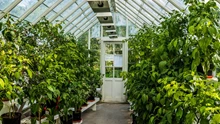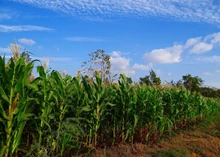
Banana is now grown in about 120 countries with a total annual production of 86 million tonnes. India leads the world in banana production with an annual production of about 14.2 million tonnes. Other leading producers are China, Philippines, Ecuador, Brazil, Indonesia, Angola, Guatemala, Tanzania, Mexico etc.
In India, banana is grown in all tropical parts and also in the mild sub-tropics. Production is maximum in Tamil Nadu which annually contributes 5136 thousand metric tonnes and the next leading States are Gujarat, Maharashtra, Andhra Pradesh, Karnataka, Bihar, Madhya Pradesh, West Bengal, Assam and Orissa.
Nowadays, banana plantlets raised from tissue-culture (micro-propagation) are available. These are very good materials for planting as the resulting plants come to flower all at the same time, fruits are borne at a shorter time, i.e., within 12 months from planting and above all, they are disease-free.
Post-Planting care has been discussed in this post. Click here to know about Banana varieties
Post-planting care:
The following particularly needs attention.
(i) Earthing up – Clumps should be in ridges in rainy-season and hence, regular earthing up is necessary.
(ii) De-suckering - Suckers compete with mother plant in respect of moisture and nutrinents and hence, are to be cut off. Without cutting, the heart may also be destroyed. In a ratoon crop, during first flowering, a half-grown sucker and another which is just emerging out should be retained.
(iii) De-navelling – When all the female and bisexual flowers have set fruits, the remaining flower-stalks having male flowers should be cut- off leaving about 10 cm distance. The cut-end should be smeared

In production, India now leads the world and out of annual global production of 86 million tonnes, the country produces 14.2 million tonnes with fungicidal paste and wrapped with colored polythene.
(iv) Weeding –Weeding is best done with a wheel-hoe or a kauri but in large plantation, chemical weedicide like 2 kg of Gramoxone or Glyphosate per hectare basis may be applied.
(v) Propping - To prevent leaning or falling of the plants due to the heavyweight of bunch or high wind, propping is necessary and this may be done with crossed bamboo poles and strong ropes. Necessity of propping is much felt in Gujarat and Malabar.
(vi) Intercropping - This may be done in the plantation but the amount of manures, fertilizers must be increased in such case.
(vii) Mulching - The practice greatly helps in soil moisture conservation and preventing weed growth. In west Bengal, mulching is much done by growers using water-hyacinth which is available in plenty. Many growers leave the plants on the field to decompose and act as manure.
(viii) Soil heating – Some growers in Maharashtra tend to burn brushwood or other materials on the land to warm the soil, in order to protect banana roots. This is a dangerous practice. By such burning, earthworms and many soils micro-flora and fauna are also killed. As a result, fertility and texture of the soil are seriously hampered and agricultural potentiality of the land is highly jeopardized. About 10 years or more time would be required for these biotic agents to reappear in the land. When cold is severe, only 1 or 2 irrigations of the land would raise its temperature to a considerable extent. Application of farmyard manure and irrigating the land just after that would be more fruitful.
(ix) Control of pests and disease – Specific control measures no doubt, be taken to control them but it should be noted that sanitary measures and applying ash on the land may ward off many pests and diseases.
(x) Ripening with carbide – Many growers and traders ripe bananas on exposure to acetylene gas. They take the fruits (=hands) in a container, put some calcium carbide into that, add a little water and close the lid. By this, the fruits are exposed to acetylene fume which is evolved. After sometime, fruits are taken out.
As acetylene gas is extremely harmful to health, the practice should be stopped. Instead, fruits may be treated with ethylene gas releasing chemical for short period. Storing the bananas in closed container along with some fully ripe guava, jackfruit, sapota etc. may be done to ripen as these fruits also emanate ethylene gas. Storing in warmth may also be done. disease.











